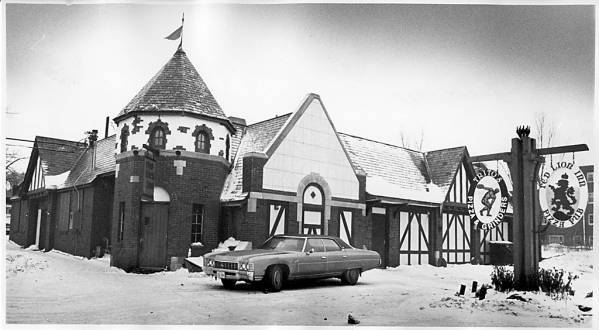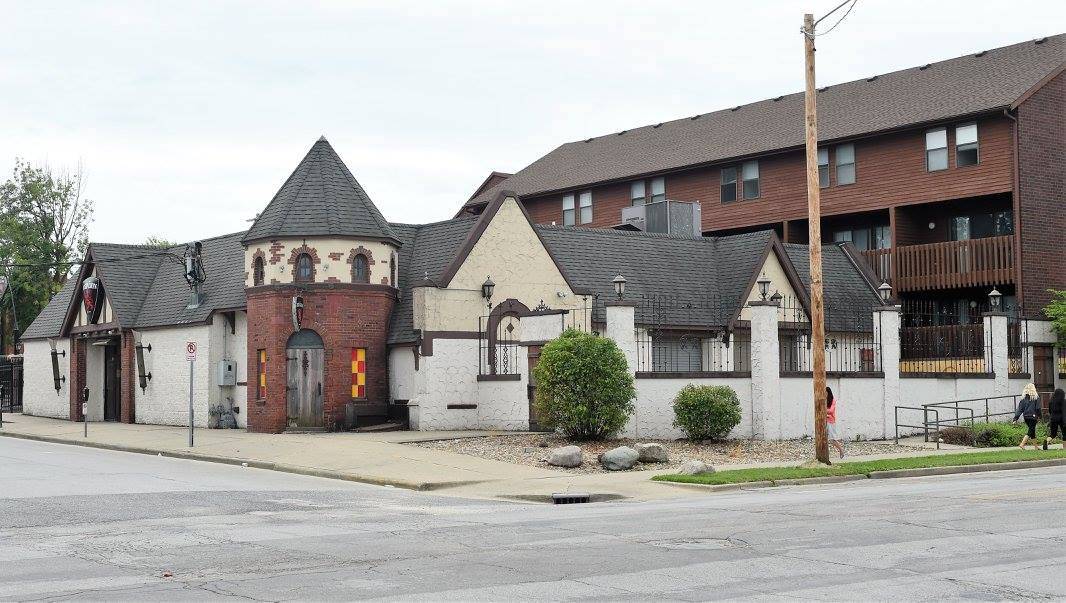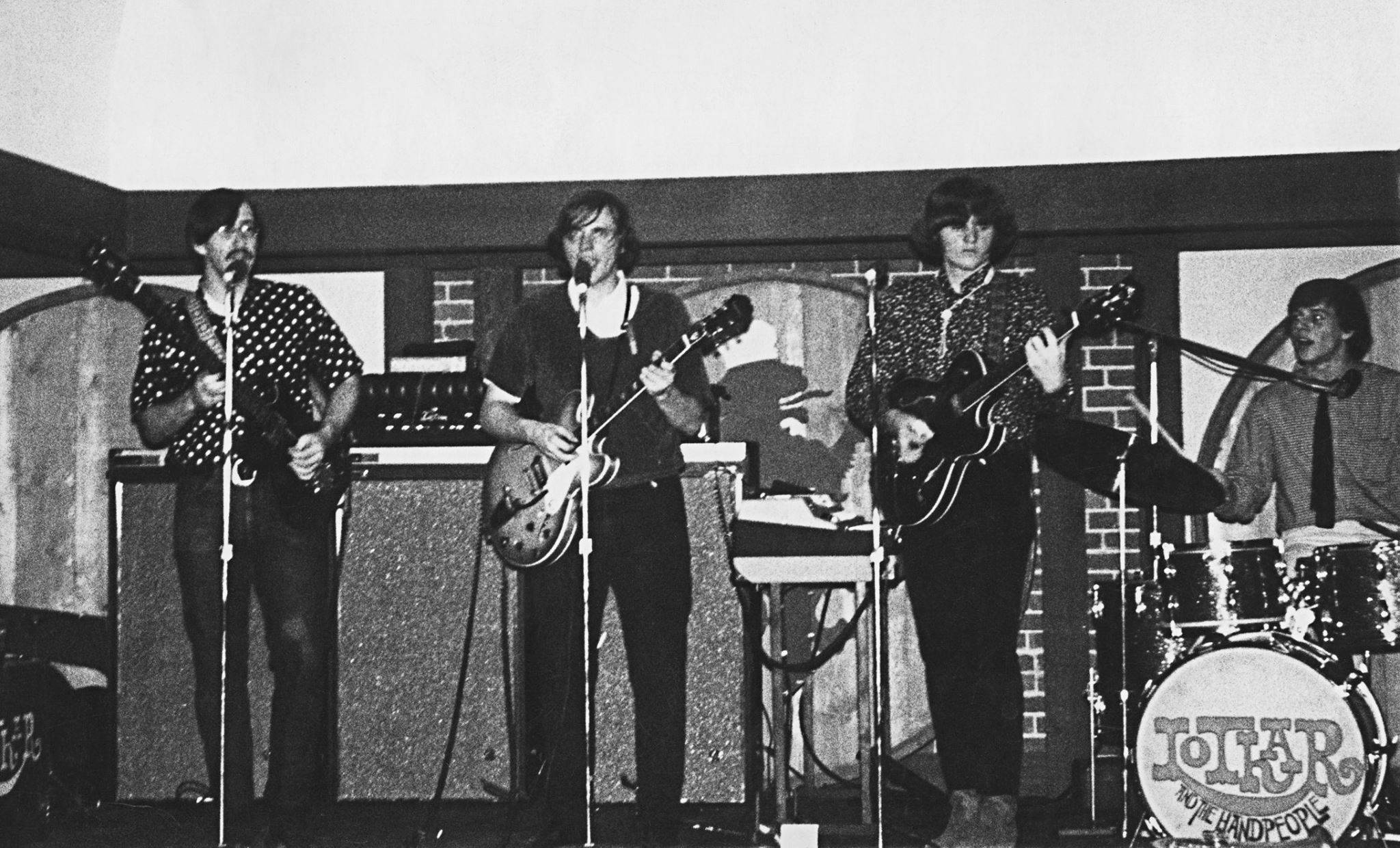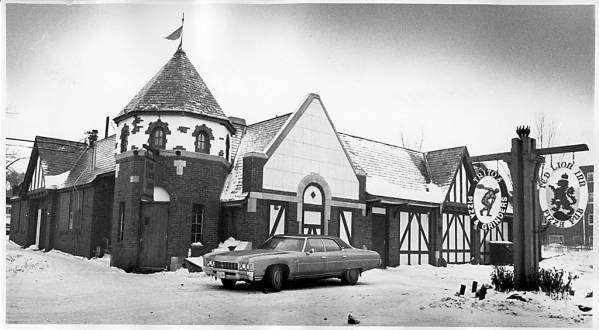
The Red Lion, circa late 1960s.
When the Red Lion Inn opened in 1966, Jimi Hendrix hadn’t yet burned his guitar in Monterey, and in Champaign County hair anywhere below the ears was considered “long”. For more than a decade, this venue and bar at 3rd and Green was the cornerstone of an exceptionally vibrant live music scene. “The Red Lion was hard rock and roll,” said Bob Graham, manager of the Lion. There were a limited number of dedicated music venues in town at the time. Over by downtown, Chances R (where Chester Street Bar is now) showcased more of a pop sound. On campus, the Red Herring attracted prominent folk musicians. But the Lion was where you went if you wanted to see loud, hard, rock music.
The list of bands who regularly played the Red Lion Inn reads like a catalogue of 70s Midwestern rock: Cheap Trick, Head East, Dan Fogelberg. Nationally touring groups visited, from Chaka Kahn and Iron Butterfly, to the obscure Danish jazz-rock/fusion band Midnight Sun. When the Ramones played the Lion in 1978 on the Rocket to Russia tour, the arrival of punk in Champaign was a notable enough event to draw local TV coverage. But the Red Lion Inn is perhaps most famous as the place where REO Speedwagon spent its journeyman years, working as a sort of house band. “They would practice every day at the Lion,” said Graham, “and then that night they would be playing there. Their whole first album was developed at the Lion.”

The Red Lion today.
According to Graham, the building itself was converted from an old gas station. It’s hard to envision what sort of gas station would have built the Lion’s Tudor-style peaks and gables, or the octagonal tower at its corner. It seems like a more fitting vibe for rock music (and no doubt inspired the Lion’s vaguely medieval name). While the building could hold around 500, the ceilings inside were low. There was barely room for the stage to be a few inches above the dance floor. “It was pretty cramped,” said Kevin “Herbie” Hisel, of late-70s new wave band the Rave, who played the Lion frequently. “Because the ceilings were so low, over the stage half the ceiling tiles were missing. Guitar players would punch through with their guitars, or they’d try to be Pete Townshend and throw their guitars up, smash the ceiling.”
The vibe was, by most accounts, was slightly seedy, and a bit dirty. With bands playing seven nights a week, most every night of the year, there wasn’t much time for cleaning. “The floors were physically sticky,” said Hisel, “but once it filled up, everyone forgot about that.” It’s been suggested that rock music, much like a fungus, requires a cool dark place to thrive. There were also drugs, certainly, but crowds were drawn in night after night primarily by nickel beers, no cover charge for students, and, most of all, a steady stream of bands with a strong regional draw: bands like the One Eyed Jacks, Starcastle, Appaloosa, or the Finchley Boys. They may not have broken through to a national audience, but in the bars of the Midwest, they were favorites.

Lothar and the Hand People playing the Red Lion Inn in 1966.
For me, the Red Lion Inn has a personal resonance, even though I wasn’t born when it shut its doors. As a high-schooler, my father, Steve Bokenkamp, was bassist for one of the first groups to play the Lion. In the winter of ’66 and spring of ’67 his group, a six-piece that went by the incongruous name “Chapter Five”, had a regular gig there on Wednesday and Thursday nights. He remembers playing “Paint It Black” and “Louie, Louie” to a crowded dance floor full of students, and the long blues jams they played once the crowd was drunk enough not to notice. “We played there long before we could legally go inside,” he told me.
There’s no doubt that the music scene in C-U was different back then, in more than just underage musicians. Local bands could, and did, play gigs four, five, or six nights a week. The workhouse Midwestern bar bands of the era toured ferociously, sometimes playing more than 300 shows in a year. Crowds demanded more cover songs from local acts, and had less patience for original numbers. Bands like Cheap Trick or REO played hundreds and hundreds of shows before writing more than a handful of songs, or recording a single note.
The money was also better. In today’s music industry, most of the money flows to big bands doing big, arena tours, while smaller bands work or tour to get by. Back then, demand for local live music was higher, with gigs available at bars, fraternities, churches, and social halls. A group of local high-schoolers (who were on the whole only moderately proficient at their instruments, according to my dad) could make $300 or $400 playing, on a good night (that’s in 1966 dollars; adjusted for inflation, it’s around $2200 to $3000). Most importantly, they could do that again and again. A consistent income, plus the time and space to practice day after day and night after night, made for the perfect growth environment for rock bands. The question isn’t why several bands from that scene went big nationwide, but, perhaps, why more of them didn’t. Fueling that growth (or exploiting it, depending on who you ask) was Blytham Limited, the management company founded in the mid-60s by Bob Nutt and Irving Azoff. Blytham represented most of the bands that frequented the Lion, from the One Eyed Jacks to the Esquires to REO. Blytham grew with the local scene, pushing artists to earn more and venues to offer more. Azoff (now a bigwig with Ticketmaster and Clear Channel) had a capitalist drive that ran against the idealism of the times. Perhaps both that urge to succeed and a sturdy community spirit, grounded in venues like the Lion, were necessary for the kind of explosion of talent those years saw.
Through hard rock, progressive rock, heavy metal, and into the punk era, the Red Lion Inn was C-U’s primary home for that growth. It was successful enough to add expansion branches in Bloomington and DeKalb, blanketing the college towns of the region. The Lion alone probably supported 20 bands, in Kevin Hisel’s estimation: “There were a lot of bands that wouldn’t have existed if not for the Red Lion Inn.”
But by the turn of the 1980s, the Lion was on its way out. Hard rock had given way to disco and synth-pop, and the economic “malaise” of the late 70s was taking its toll. In addition, the drinking age, lowered for a time to 19, was raised back to 21 in 1980, costing the Lion some of its younger crowd according to Graham. It closed in 1981. Later, a string of different owners acquired the building and opened the bar under different names, until in 2010 it was renovated and dubbed the Red Lion once again. Now it’s serves as one of several bars in the Green Street area with a DJ’s pounding bass and a long line leaking out the door on weekend nights. Live music is superfluous when a fratty crowd is willing to pay the $5 cover. (Yelp review highlights include: “countless airborne beverages”, “everything is sticky”, “the drinks are underwhelming”, and “eeeeeeewwwwwwwwwwwwwwwwww”. At least the sticky floors sound like they haven’t changed.)
The Rave were regulars playing at the Lion in its latter years. They played there enough nights that the only document of the 1977–1981 of their original lineup is a set of 8-track reels, recorded live at the Lion in ’79. The band members finally released those recordings in 2012, opening a kind of audio time capsule.
The sound quality is clear, the crowd enthusiastic, and the band lively but driven.
Their original songs hit the power-pop bullseye, combining the sweetness of Big Star and the muscularity of Cheap Trick.
There’s a handful of die-hard fans who chant the song titles, even before the band calls them out. Covers of the Talking Heads songs that mesh well with the rest of the set. It feels like a strong, practiced band, playing at the peak of its powers.
Listening to it, you can hear what the Red Lion Inn was first and foremost to the bands of its era: a damn good place for rock and roll.
——————-
The Red Lion Inn 50th Anniversary will be at City Center, at 505 S Chestnut, Friday and Saturday nights. Acts performing include The Lugnutz, Herbie & The Wolf (from The Rave), the Tons O’ Fun Band, Appaloosa, Ginger, the Finchley Boys, and Slink Rand. Doors at 4pm, shows begin at 5. Tickets are $20. A full lineup of bands playing can be found on the Facebook page for the show. Proceeds will benefit The Alice Campbell Alumni Center’s planned exhibit on student life through the decades.
Nathaniel Forsythe is a writer living in Champaign. That’s the truth. He ain’t lion.








